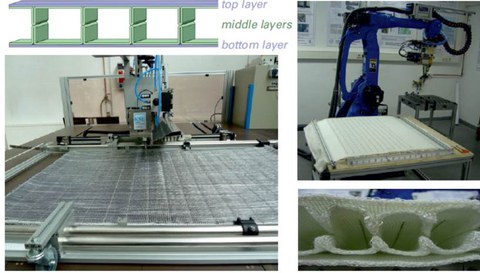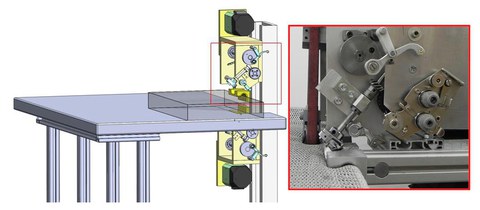Trenn- und Fügetechnologien

CNC-Nähtechnik und Nähroboter in der Prozesskette zur konfektionstechnischen Preformfertigung
Gegenstand sind die Fügeverfahren Nähen, Schweißen und Kleben, die Verbindungsprozesse, deren Prozessparameter, die Entwicklung und Konstruktion von Maschinen sowie die Anwendung dieser Techniken zur textilen Montage von Technischen Textilien, Heim- und Raumtextilien sowie Funktionsbekleidung mit speziellen Nahteigenschaften. Insbesondere die Montageprozesse Technischer Textilen und Preforms für Faserkunststoffverbunde erfordern anwendungsangepasste Montagetechniken und -technologien mit integrierten Sensoren und Aktoren zur reproduzierbaren Nahtausführung.
Die Nähtechnologie ist ein textiltypisches Fügeverfahren und universell für eine breite Palette biegeweicher Materialien geeignet. Einen Schwerpunkt am ITM bilden 3D-Nähtechnologien, die insbesondere Potenzial für die Fertigung von Technischen Textilien, z. B. Auto-Kopfstützen und -Sitze sowie komplexe Preforms aus Hochleistungsfaserstoffen, besitzen. Das Nähen im Raum erfolgt mit einseitig arbeitenden Nähköpfen, die mit einem Gelenkarm-Roboter entlang eines 3D-Formkörpers mit produkt- bzw. preformnaher Geometrie geführt werden, auf denen die Zuschnittteile positioniert sind.
CNC-Nähtechnik in 2D-Arbeitsweise wird u. a. zur konfektionstechnischen Realisierung ebener und gekrümmter textiler Spacerstrukturen, zur Fixierung mehrlagig aufgebauter Preformarchitekturen und zur Integration von Elektronikbaugruppen und Inserts eingesetzt.
Weiterhin werden am ITM neuartige Nähtechnologien entwickelt sowie Maschinenkonzepte und Nähwerkzeuge in enger Zusammenarbeit mit der Industrie realisiert.

Technologiekonzept und Realisierung zur dreidimensionalen Kantenbearbeitung von Abstandsgewirken, Maschinenrealisierung in Zusammenarbeit mit der Firma Pfeil Nähmaschinen GmbH
Textile Schweißtechnologien nutzen zur Erwärmung des thermoplastischen Materials bzw. zur Aktivierung der thermoplastischen Klebstoffe Ultraschall, elektrische Hochfrequenzfelder oder Heißluft. Durch die stoffschlüssige Verbindung der textilen Zuschnittteile lassen sich spezifische Nahteigenschaften für Anwendungen im Membranbau, im Medizin- und Pflegebereich und im Arbeitsschutz erzielen. Dies erfordert eine an das Material und die Applikation angepasste Prozessgestaltung und Eigenschaftsauslegung. Im Fokus stehen Prozessuntersuchungen durch messtechnische Erfassung der Prozess- und Maschinenparameter im Zusammenhang mit den Materialeigenschaften und den resultierenden Nahteigenschaften. Qualitätskontrolle und Prozessoptimierung ermöglichen somit eine gezielte Anpassung der Produkteigenschaften während des Fügens.

Prozessuntersuchungen in der Fügezone beim Ultraschallschweißen und Nahtquerschnitt
Für die Forschung auf dem Gebiet der Fügetechnologie stehen konfektionstechnische Labore mit einer umfangreichen Maschinenausstattung zur Verfügung.
